The presence of algae in the aquarium indicates that the tank has developed its own bio-balance. Algae appear on all elements located in the tank. If they increase quite rapidly, then this negatively affects the general condition of all fish. Only timely maintenance of the aquarium ensures optimal maintenance of the amount of algae. But if brown formations were detected in the tank, then these are brown algae.
It is necessary to consider in more detail the reasons for the active propagation of algae, as well as what methods can cope with the problem.

Description
Brown algae are microorganisms that spread both single cells and forming colonies. They belong to diatoms, that is, they are divided into two parts - the epithecus and the hypothec, united by a single rather solid, but porous shell, which is responsible for the metabolism of algae.
With the help of division, algae multiply. When the daughter is separated from the mother, the first part is the part of the shell of the mother, in the future each of them will recreate a new armor. The carapace has silica impregnation, as a result, it cannot change in size. This leads to the fact that each next generation is smaller in size. But this does not prevent the algae from leaving their plaque on the surface of the aquarium.

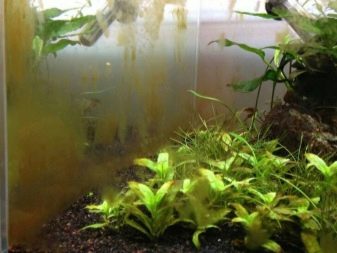
Aquarium brown algae often form tubular colonies, in which case they look like bushes.
They usually grow rapidly, and reach a height of up to 20 cm. Although they are usually represented by flat formations, which we consider as plaque. Brown algae usually accumulate in shaded corners, where a large amount of organic matter is present. With their active reproduction, other inhabitants of the aquarium suffer.
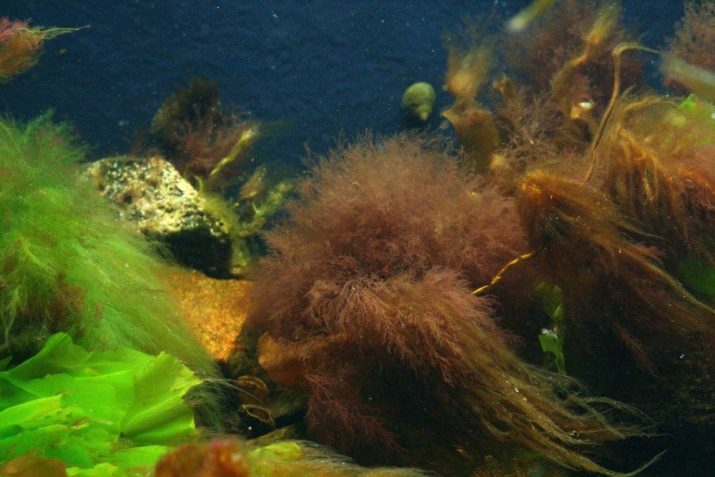
Symptoms of occurrence
A distinctive feature of the presence of diatoms in the aquarium is the appearance of a brown dust-like coating. It manifests itself on various surfaces - on leaves, stones, walls of the aquarium, plants.
Brown plaque in the aquarium indicates the active development of brown algae, because every day the plaque becomes darker.
If you start the fight in the early stages, then plaque on the scenery or steles can be easily removed with a rag, and from the leaves of plants it can simply be shaken off. It is worth noting that such a coating is quite dusty, since a dust cloud forms when shaken off.
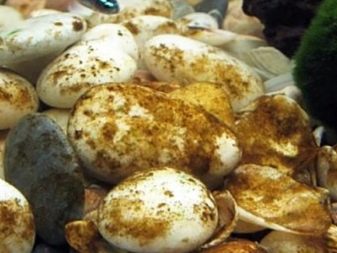
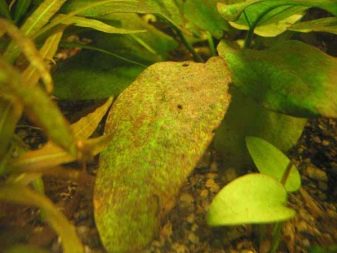
Over time, the coating becomes black, as the layers begin to overlap. Moreover, if the upper layer is dusty, then the lower layers are quite difficult to erase usually with a rag. One gets the impression that all the objects in the aquarium were covered with dark, almost black, sand. As such, it is quite difficult to see the contents of the aquarium through the glass.
If brown algae appeared in large numbers, then the fish will not feel big changes, but the plants can suffer. The resulting spots on the leaves of plants prevent the normal passage of photosynthesis. If you do not respond to the situation, then the plants will die. Plaque appears rather quickly on new leaves. If you cannot cope with it in time, then on its basis more complex algae can appear at a distance, such as black beard.
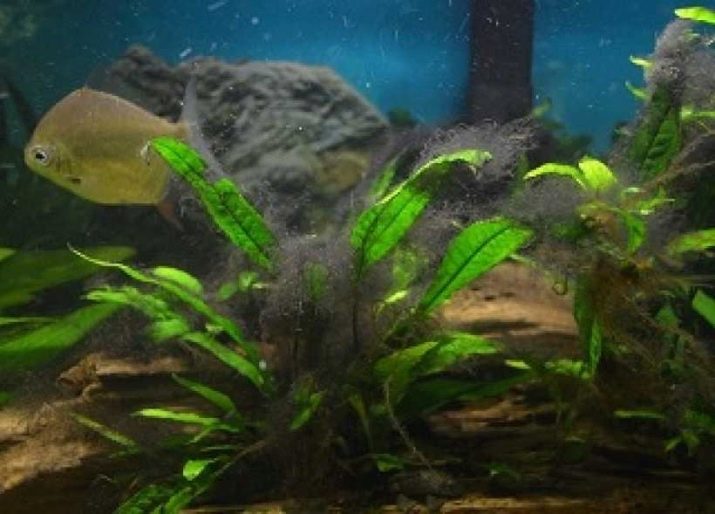
Reasons for the appearance
It is very important to initially know the age of the aquarium from its launch or restart. This indicator will be decisive in determining the causes.
New aquarium
If the aquarium is used for no more than three months, then brown algae appears, because the plants have not yet taken root, and the nitrogen cycle has not been established. It is the excess of organics that is the cause of the emergence of these living microorganisms, since it leads to rotting processes. It is worth noting that The pH of fresh water is slightly alkaline or neutral, so some essential compounds for plants are not yet available.. So, if pH <7, then ammonia will be presented in a form accessible to plants, and already at pH> 7 ammonia is already used as algae nutrition.
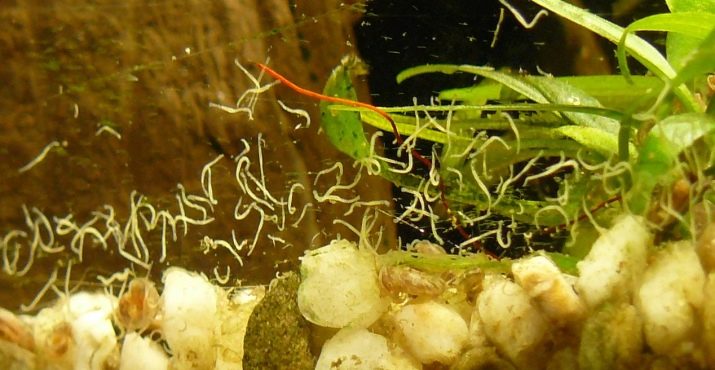
Many beginner aquarists make quite a long daylight hours.
It is not worth initially lighting the tank for 12 hours, since algae will appear at 100%.
If you adhere to the correct launch of the aquarium, as well as apply bacterial powders, then this problem simply will not arise. Do not immediately fertilize the “fresh” aquarium. Experts recommend the first 1-2 months to add exclusively potassium to the water, which will prevent brown coating on the bottom of the aquarium.
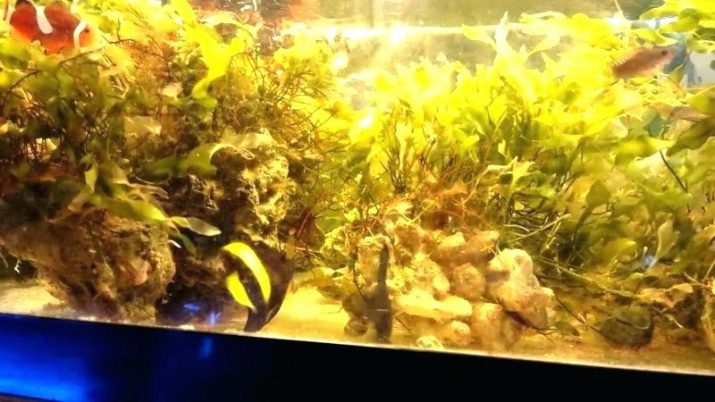
Old tank
If we consider a long-launched aquarium, which already has its own balanced ecosystem, then the reasons for the appearance of brown algae will be different than in the new aquarium. The most common cause is a large accumulation of organic matter. This can happen if the fish does not eat the food, and part of it just settles to the bottom, water is rarely replaced, and the filter is already clogged.
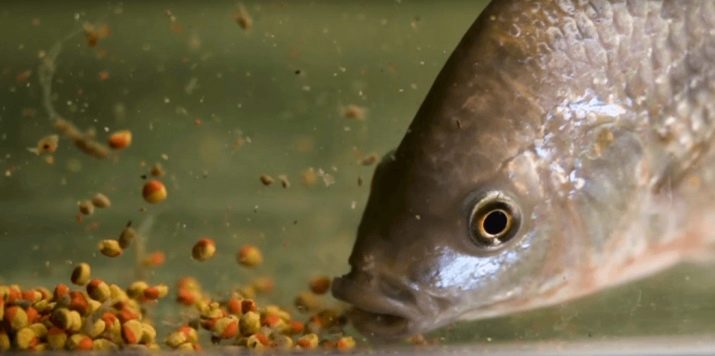
Then all objects in the aquarium are covered with a brown coating. If you do not replace the lamps in the aquarium on time or make a sharp replacement of the lamps, this can also cause the appearance of brown algae.Replacing bulbs should occur gradually, it is worth sticking to a gap of about 3 to 4 weeks, so plants can quickly adapt to new lighting. Diatoms usually appear in containers with a water temperature below +22 degrees, since they prefer cool water.
A brown coating may appear if the fish were treated in the total capacity. Typically, the toxic substances contained slow down the development of plants, thereby affecting the ecological balance of the aquarium. As a result, brown algae appears. The same situation may occur after using salt.
Important! If one person takes care of the aquarium, then a peculiar regime is established. If then another person begins to care for the aquarium, then a change in the internal ecosystem is possible.
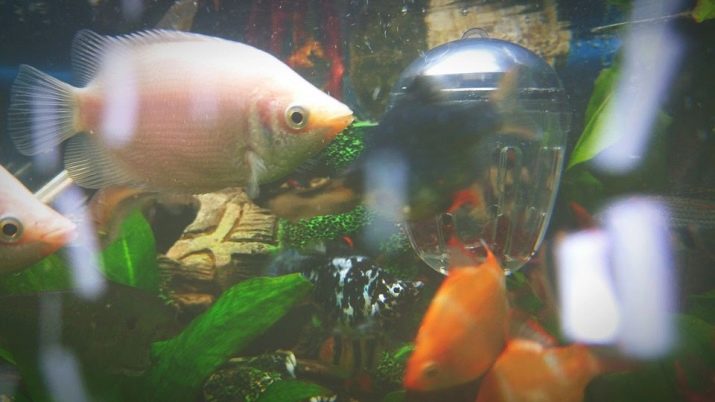
What tools can I use?
In order for the fish and plants to feel good, it is necessary to get rid of the brown coating in time, to fight against brown algae, adhering to the following recommendations:
- if you consider a fresh aquarium, then mechanical cleaning will help - you should carefully remove all plaque using a conventional blade or a special scraper;
- to clean the leaves of plants from plaque, you do not need to use sponges or foam rubber, just carefully remove it with your hands so as not to damage the plant;
- plaque is formed quite quickly at the bottom of the aquarium, so it should be cleaned quite often with a hose;
- during a water change, it is worth removing plaque from the decor, shells, pebbles and pebbles, and it is enough to rinse them under water;
- Compressor hoses and filters need regular flushing;
- an excellent solution would be to purchase fish that like to eat brown algae - catfish Antsistrus, girinoheylus and Siamese algae;
- it is better to refuse chemical preparations, since they will not only destroy algae, but also harm plants and fish in the aquarium, although some antibiotics, such as penicillin, are allowed.
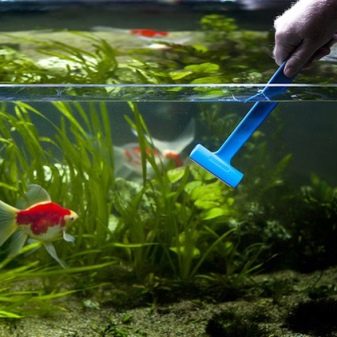

Methods of struggle
The sooner you start the fight against diatoms, the better, because at the initial stage it is much easier to get rid of them. Consider the main methods of eliminating brown algae.
Optimal conditions
It is necessary to create and maintain optimal conditions for the normal growth and development of plants and fish in the aquarium. It is necessary to adhere to the correct daily routine, water parameters and temperature. To deal with brown plaque, it is necessary to organize proper care for the aquarium. Usually it appears with poor-quality cleaning.
Water should be replaced every week with 1/3 or ¼ part. If the aquarium is severely affected by brown algae, then it is worth changing the water more often. The water temperature should be at least +22 degrees, if it was less, then it is definitely worth raising it even to +24 degrees. The fish will feel fine, but algae will definitely not like it.
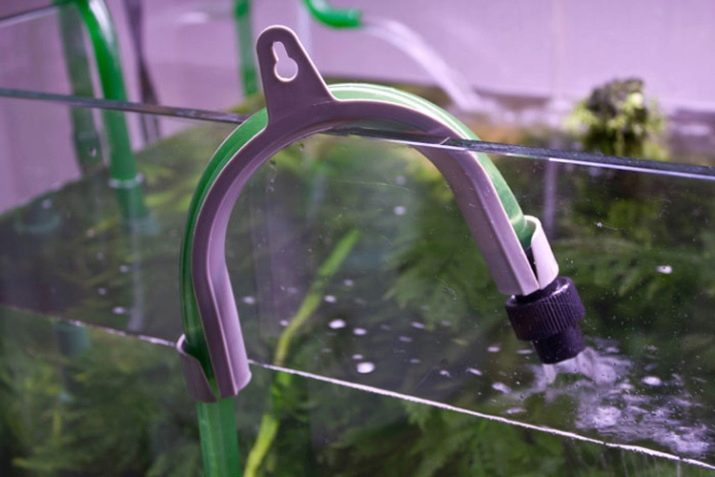
You should not overfeed the fish, since plaque is often formed against the background of a large amount of organic matter.
Fish should completely eat all the food in 15 minutes. If they cannot cope with the proposed portion during this time, then it is worth reducing their portion, and all settled organics should be removed from the aquarium to prevent the process of decay.
The number of fish also affects the possibility of brown algae. With a heavily populated aquarium, it is more often necessary to clean, siphon the soil and purify the water. Pay attention to the quality of tap water.
If it contains a lot of phosphorus, then this can also contribute to the development of brown plaque.
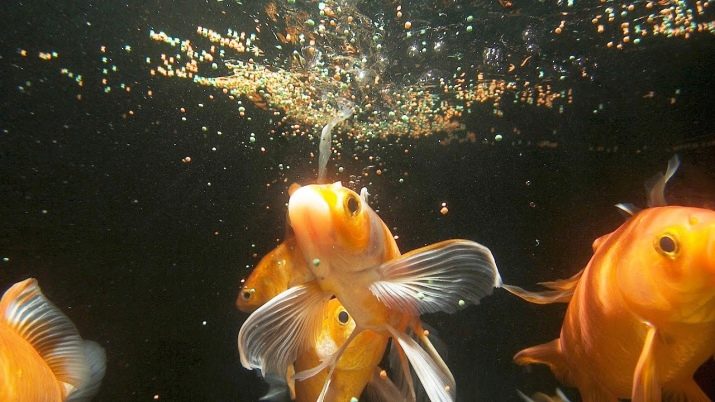
Lighting
Quite often, lighting an aquarium tank plays a decisive role in the formation of an unpleasant plaque. It can be either a very long or a very short day. If the aquarium is still “fresh”, you should exclude the provision of a long day.To cope with the problem, it is enough to stick to the 6-hour day for only 3 days in a row. Then you can return to normal mode - 10-hour. Regularity of the regime will ensure the cleanliness in the aquarium and the health of your fish.
Lamps with an expiration date should be discarded. Although a sharp replacement is also not recommended. It is worth changing them in stages - one after another, while the interval should be approximately 3 weeks between their replacement. With a quick change in lighting, algae will actively propagate. Only use lamps designed for the aquarium. Their power is 1 W / liter.
Important! If the aquarium is exposed to direct sunlight for a long time, the appearance of a brown coating is inevitable.
It is worth limiting the time to 2-3 hours a day.
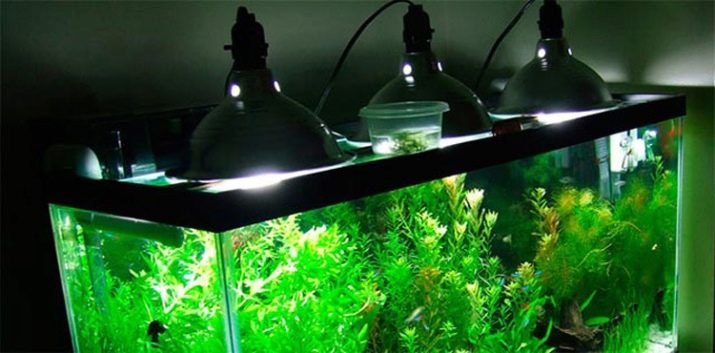
Chemical methods
These methods should only be used if the above measures have not helped. It is worth remembering that chemistry affects the state of the entire ecosystem. Typically, drugs like Bicillin-5, Penicillin or Algetten are used to combat plaque. They allow you to quickly eliminate the formed plaque, but it again appears with time, if not to eliminate the cause.
Mechanical cleansing
If the aquarium is young, accordingly, the ecosystem has not yet formed, so the appearance of brown algae is not at all scary. It is enough to use mechanical action to clean the tank from plaque. Usually it is easily wiped even with your fingers.
To eliminate strong plaque from the walls of the aquarium, it is worth using scrapers, brushes or sponges.
If the plaque needs to be removed from the leaves of plants, then it is worth acting very carefully. If the leaves already begin to decompose under the influence of algae, it is better to dig out such a plant from the aquarium, or cut off the diseased leaves.
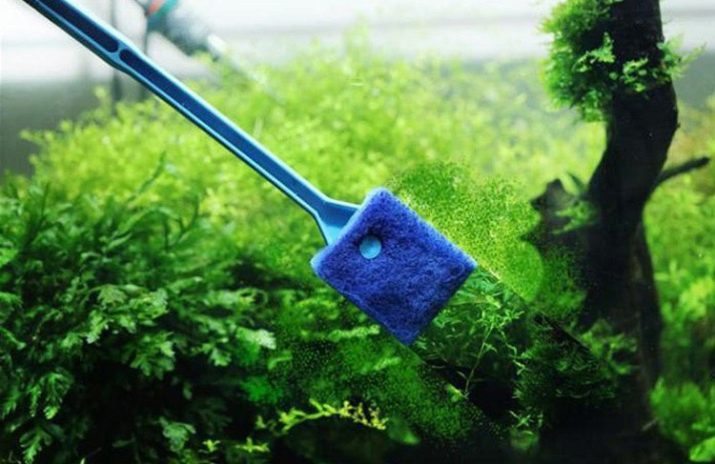
Biological fight
The biological method is the removal of algae with the help of other inhabitants of the aquarium. Brown algae like to feast on snails, mollusks, shrimps, algae eaters, ancistruses, catfish girinohejlusy and catfish ototsinkllyusy.
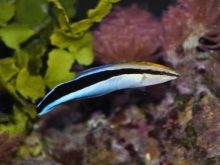
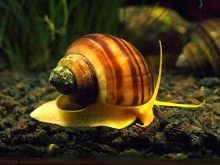
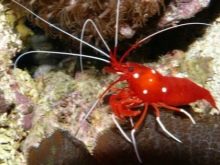
Prevention
For preventive purposes it is worth sticking to some recommendations of specialists.
- Create optimal lighting in every corner of the tank. When the day is too short, you should use additional lighting, an excellent solution would be to use lamps with red spectral light.
- You should adhere to a water temperature of +22 to +26 degrees Celsius, as brown algae breed in cool water.
- It is necessary to regularly replace the water, while not forgetting to take into account the pH level, the amount of silicates, phosphates, iodine and nitrates. You should take purified water, not running water.
- It is necessary to put filters that can rid water of silicates.
- Make plants populate the aquarium so that algae get as little nutrition as possible.
- Experts advise putting a piece of copper or zinc at the bottom of the aquarium, since these metals can get rid of brown algae.
- After cleaning the aquarium, it is worthwhile to provide maximum lighting for a while, which will completely get rid of this problem.
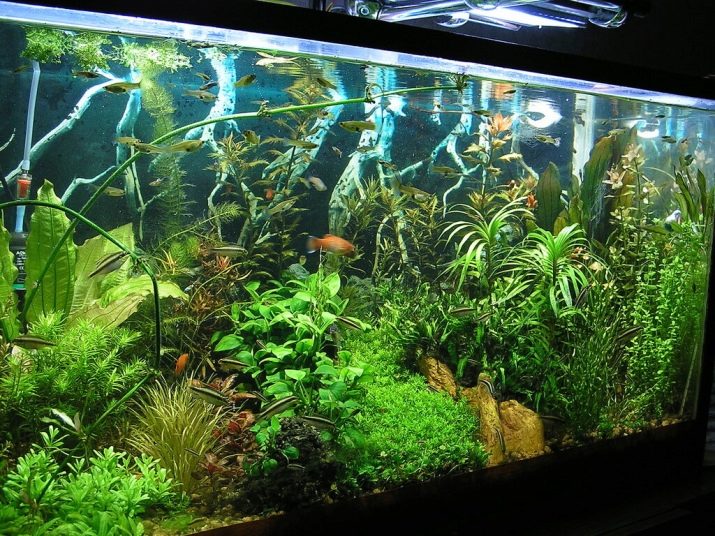
How to get rid of brown algae in an aquarium without chemistry can be found in the video below.










